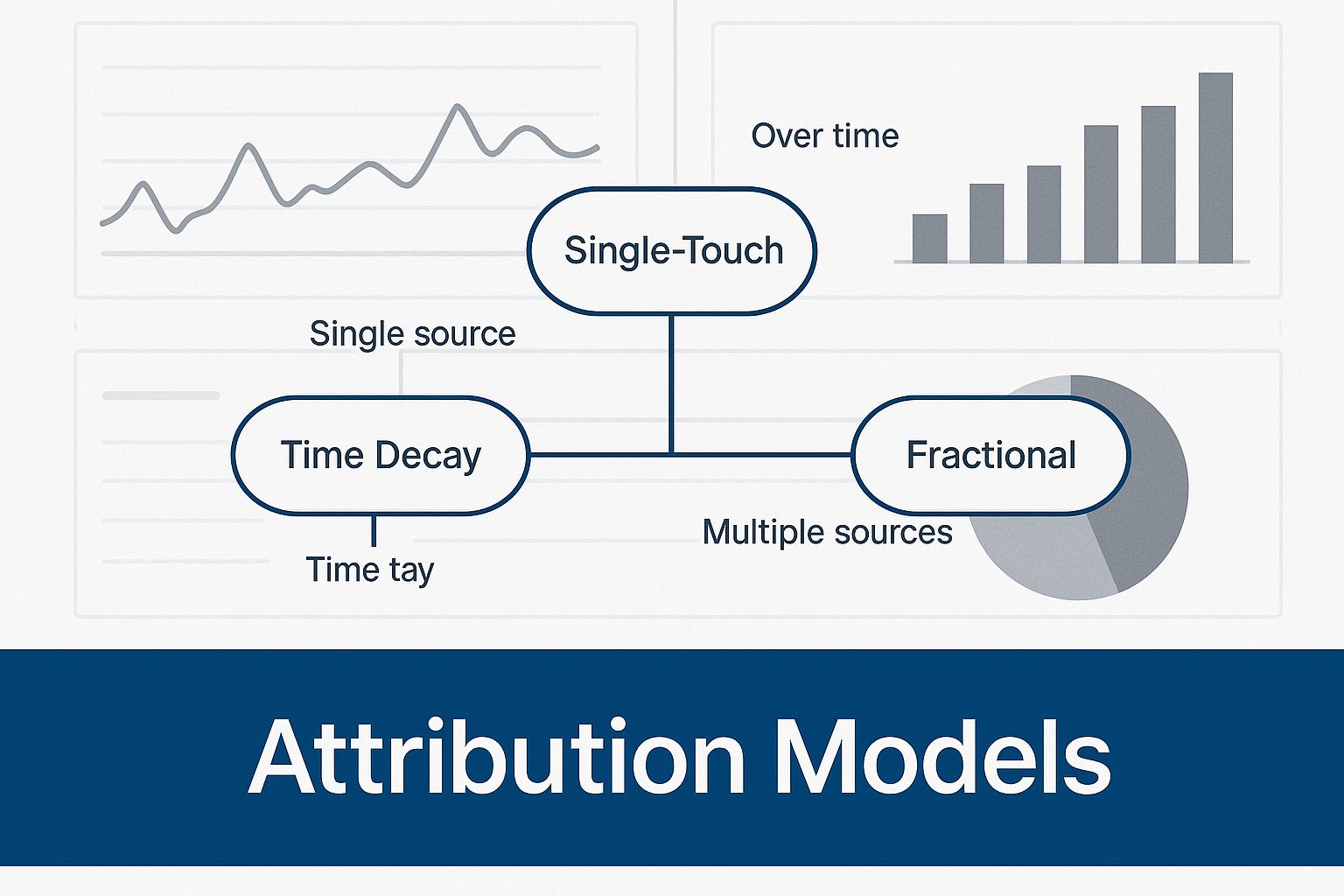Master Cross-Channel Marketing Attribution for Profitable Scale
Discover how cross-channel marketing attribution unlocks insights, boosts ROI, and helps optimize your ad spend effectively. Learn more today!

Cross-channel marketing attribution isn't just about tracking clicks—it's about understanding the complete story of how a customer discovers and buys your product. For e-commerce leaders, it's the critical link between a Meta ad that sparked initial interest, a Google search that provided answers, and the final Amazon PPC ad that closed the deal. It replaces fragmented, siloed data with a unified, performance-first view of what's actually driving profitable growth.
Why Your Marketing Budget Is Leaking Money

If you're running ads on Google, Meta, TikTok, and Amazon but can't draw a straight line from that spend to your P&L, you have a leaky budget. This is a common but costly problem for e-commerce brands, forcing leaders to make critical investment decisions through the narrow, warped lens of data trapped in platform silos.
This tunnel vision is a direct result of clinging to an outdated attribution model: last-click attribution. This model gives 100% of the credit for a sale to the final touchpoint a customer engaged with before converting, ignoring the rest of the journey.
The Problem with Last-Click Logic
Consider a typical customer journey. A shopper sees your brand for the first time in a TikTok video. A few days later, they Google your product and click a search ad to learn more. A week after that, they're on Amazon, see one of your Sponsored Products ads, and make the purchase.
The last-click model gives the Amazon ad all the glory. The TikTok and Google ads, which were instrumental in building awareness and driving consideration, are logged as having zero value.
This flawed logic leads to disastrous business decisions:
- You might kill "underperforming" top-of-funnel campaigns, inadvertently cutting off your primary source of new customers.
- You could over-invest in bottom-funnel Amazon ads, mistakenly believing they are solely responsible for your sales volume.
The bottom line is simple: you cannot scale what you cannot measure accurately. Relying on last-click attribution is like trying to build a puzzle with pieces from different boxes—you will never see the full picture of your customer's journey or the true ROI of your marketing spend.
The High Cost of the Attribution Gap
The modern customer journey is a complex web of interactions spanning social media, paid search, influencer marketing, and email. Yet despite massive investments in digital advertising, a shocking 70% of retailers admit they can't fully connect their online marketing efforts to actual sales. This "attribution gap" is a silent killer of profitability, a problem detailed further in this guide on connecting digital campaigns to sales.
A true cross-channel view is not a "nice-to-have"; it's a strategic imperative for making smarter, more profitable decisions.
The Shift from Last-Click to Full-Funnel View
This table illustrates why moving beyond last-click isn't just an analytical upgrade—it's a fundamental shift in business strategy.
| Attribution Approach | What It Measures | Business Impact |
|---|---|---|
| Last-Click | Only the final interaction before a sale. | Skewed data, poor budget allocation, and missed growth opportunities. Leads to overvaluing bottom-funnel ads and undervaluing top-of-funnel awareness. |
| Cross-Channel | Every touchpoint in the customer's journey. | Accurate performance insights, optimized spending across the full funnel, and sustainable, profitable growth. Uncovers the true value of each channel. |
Ultimately, this shift transforms attribution from a reporting task into your brand's financial control panel. It empowers you to see exactly how your ads on platforms like Google and Meta are fueling sales on Amazon, so you can finally plug the leaks in your marketing budget for good.
Choosing the Right Attribution Model for Your Goals
Selecting an attribution model is a strategic decision that must align directly with your business objectives. Think of it like assigning credit for a goal in soccer. Does the credit go only to the striker who scored? Or do you acknowledge the midfielder's assist and the defender who initiated the play? Each model provides a different lens for evaluating performance.
The right model for a brand launching a new product will be different from one focused on maximizing repeat purchases. Getting this right is the difference between staring at confusing data and unlocking actionable insights that drive performance.

As you can see, a proper attribution framework isn't about finding one magic number. It's about understanding how all your channels collaborate to generate revenue.
Single-Touch Models: A Limited, Incomplete View
Single-touch models are the most basic, assigning 100% of the credit for a conversion to a single interaction.
- Last-Click Attribution: The default for most ad platforms, it credits the final touchpoint. It's useful for identifying which channels close deals but dangerously oversimplifies the journey by ignoring everything that came before.
- First-Click Attribution: The opposite of last-click, it credits the very first touchpoint. This is valuable for brands prioritizing new customer acquisition and understanding which channels are best for generating initial awareness.
While simple, these models provide a dangerously incomplete narrative. Relying on them is like judging a movie by only watching the first or last scene—you miss the entire plot.
Multi-Touch Models: Gaining a More Accurate Picture
Multi-touch models acknowledge the reality that a sale is the result of multiple interactions. They distribute credit across various touchpoints, providing a more complete and actionable view of performance.
Here's a breakdown of the most common multi-touch models:
- Linear Model: This model splits credit equally across every touchpoint. Its weakness lies in treating a fleeting social media impression with the same weight as a deliberate click on a search ad.
- Time-Decay Model: This model assigns more credit to touchpoints that occur closer to the conversion. It’s highly effective for products with longer consideration periods, like electronics or furniture, as it correctly weights the final, decisive interactions more heavily.
- U-Shaped (Position-Based) Model: A popular and balanced approach. It gives 40% of the credit to the first touchpoint (discovery) and 40% to the last touchpoint (conversion). The remaining 20% is distributed among the interactions in the middle. This model values both customer acquisition and closing effectiveness.
The Headline Recommendation: Align Model to Goal
For most e-commerce brands, particularly those driving external traffic to Amazon, the U-Shaped model provides the most actionable insights. It properly credits top-of-funnel channels like Meta or TikTok for creating new demand while also valuing the bottom-funnel channels, like Amazon PPC, that capture it.
The ultimate goal, however, is to evolve toward a data-driven attribution model. This advanced approach uses machine learning to analyze your unique customer journeys and assign credit based on what actually influenced the purchase, removing guesswork entirely.
For a deeper dive into how these models apply specifically to the Amazon ecosystem, explore our guide on Amazon advertising attribution. Choosing the right model is the first step toward building a marketing engine that scales profitably because it ensures you're investing where it matters most.
How to Build Your Attribution System

Let's move from theory to execution. Building a robust attribution system means creating a single source of truth for your performance data. This isn't about finding a magic-bullet software; it's about a disciplined methodology for gathering, connecting, and analyzing data from every corner of your marketing ecosystem.
The objective is to see precisely how your off-Amazon investments on platforms like Google or Meta directly impact sales on Amazon. This is an ongoing discipline, but a solid foundation provides a massive competitive advantage, enabling you to ditch guesswork and make decisions that drive profit.
Step 1: Unify Your Critical Data Sources
First, you must break down the data silos. Your performance data currently lives in isolated worlds: Google Ads, Meta Ads, and Amazon Seller Central. None of them talk to each other, which clouds your judgment. A true attribution system requires a unified view of every dollar spent and every customer interaction.
These are the core data sources you must bring together:
- Ad Platform APIs: This is non-negotiable. You need direct data feeds from Google Ads, Meta Ads, TikTok Ads, and the Amazon Ads API to get raw spend, impression, and click data.
- Amazon Organic & Retail Data: Pull reports like the Search Query Performance report to see how your brand shows up organically. Integrate retail data to understand the impact of promotions, stock levels, and pricing on campaign performance.
- eCommerce & CRM Data: Your own data from platforms like Shopify or BigCommerce holds the final conversion piece. This is how you connect ad traffic to actual sales, customer lifetime value (LTV), and repeat purchases.
Unifying these sources allows you to see the entire journey. You can finally connect a surge in Google Ads spending to a lift in branded searches and organic sales on Amazon—a profit-driving connection that is invisible when data remains siloed.
Step 2: Choose Your Tooling Strategy
With your data sources identified, you need a way to bring them together. You have two main paths: an all-in-one platform or a custom-built stack. The right choice depends on your team's technical capabilities, budget, and strategic goals.
| Tooling Strategy | Pros | Cons |
|---|---|---|
| All-in-One Platforms | Faster setup, less technical overhead, and pre-built attribution models. Gets you to insights quickly. | Can be less flexible, may not integrate with all of your specific tools, and can feel like a "black box" where you don't control the logic. |
| Custom Stack | Complete control and customization, ability to integrate any data source, and transparent logic. | Requires significant technical resources (data engineers, analysts), longer build time, and ongoing maintenance. |
For most brands, starting with a robust all-in-one platform is the smart move. It delivers valuable insights quickly without the need to hire a team of engineers. You can always evolve to a custom solution as your business scales and your needs become more complex.
Step 3: Master Your UTM Tagging Strategy
This is the single most critical—and most frequently botched—step. Without a consistent and enforced UTM tagging strategy, your entire attribution system is built on a foundation of bad data. Garbage in, garbage out.
UTM parameters are the snippets of code added to your URLs that tell your analytics tools exactly where a visitor came from. A disciplined, company-wide strategy is non-negotiable.
Key Takeaway: An inconsistent UTM strategy is the #1 reason attribution models fail. You must create and enforce a standardized naming convention for source, medium, and campaign parameters for every external link pointing to your site or Amazon store.
For example, a link from a Facebook ad for a summer sale should look like this:
yourproduct.com?utm_source=meta&utm_medium=cpc&utm_campaign=summer-sale-2024&utm_content=video-ad-1
This simple tag allows you to isolate the performance of that specific creative within your analytics, connecting spend directly to traffic and conversions. Enforcing this discipline ensures every touchpoint is correctly labeled, making your attribution reporting accurate and trustworthy.
The Business Impact of Getting Attribution Right
What does accurate cross-channel attribution actually do for your bottom line? This isn't an academic exercise; it's a direct path to higher profitability, increased market share, and sustainable scale.
When you connect your data, you stop making decisions in the dark. You can see precisely how your investment in a Meta awareness campaign or a Google search ad translates into real revenue on Amazon. This unlocks a more intelligent, performance-first approach to budget allocation.
From Leaky Budgets to Profitable Investments
Without a clear view of the full customer journey, you're guessing where to invest your next marketing dollar. With proper attribution, every dollar becomes a calculated investment. You can finally answer critical business questions with confidence:
- Higher ROAS: Which top-of-funnel channels are really introducing new customers who eventually buy on Amazon? You can confidently shift budget to these workhorses and cut spend on channels that only look good on a last-click report.
- Increased Customer Lifetime Value (LTV): By analyzing the entire journey, you can identify the sequence of touchpoints that creates high-value, repeat buyers and build a strategy to replicate that success.
- Improved Organic Rank on Amazon: You can finally prove the connection between external ad spend and organic search rank on Amazon. A well-placed external ad can drive a surge of branded searches on Amazon, signaling to the A10 algorithm that your product is in demand and boosting your organic visibility—a powerful flywheel effect.
The Power of Connecting Off-Amazon Ads to On-Amazon Sales
The data is clear. Brands that effectively integrate their marketing channels see an average customer retention rate of 89%, dwarfing the 33% rate of companies with weak cross-channel strategies.
Furthermore, customers who engage with a brand across multiple channels have a 30% higher lifetime value, and campaigns running on three or more channels see a 14.6% higher sales lift. If you want to dig deeper, you can explore more stats on why cross-channel is a financial must.
For Amazon-centric brands, this connection is the key to unlocking the PPC-for-organic-growth flywheel. Your external ads don't just drive a single sale—they build momentum that elevates your entire Amazon presence.
Case Study in Action: Driving Performance for a Supplement Brand
Imagine a supplement brand pouring money into Meta and Google ads to build awareness, but all sales are captured on Amazon. From a last-click perspective, the external ad spend appears to be a money pit, while Amazon PPC seems to be doing all the work.
This was a real challenge for one of our clients. By implementing a cross-channel attribution system, we uncovered a game-changing insight.
The unified data showed that customers who first saw the brand on a Meta ad had a 25% higher conversion rate on Amazon within seven days compared to those who hadn't. Those Meta campaigns weren't just "brand awareness"—they were priming high-intent buyers.
This single insight completely reshaped their strategy. They began scaling Meta ad spend with confidence, targeting lookalike audiences modeled after their best Amazon customers. The result was a significant increase in market share and a measurable lift in profitability—all because they were no longer flying blind. They were using off-Amazon PPC as a strategic lever to win on Amazon, a strategy similar to how we helped another supplement brand increase revenue by 25x.
The takeaway is clear: Your marketing channels are not separate islands. They are interconnected parts of a single growth engine. Understanding how they work together is the key to unlocking real, sustainable profitability.
How to Overcome Common Attribution Roadblocks
Let's be direct—implementing cross-channel attribution is challenging. Most brands hit the same frustrating walls: messy customer journeys, fragmented data, and platform "walled gardens" that refuse to share information.
But these are solvable problems. With a smart strategy and a relentless focus on performance, you can break through these barriers. The key is to address each challenge with a clear, no-nonsense plan.
Navigating Platform Walled Gardens
The biggest headache is the “walled garden” problem. Giants like Amazon, Google, and Meta operate closed ecosystems, making it a nightmare to track a user who clicks a Facebook ad, performs a Google search, and finally buys on Amazon. Each platform wants to take full credit, leaving you with skewed, unusable data.
To get a clear picture, you have to stitch the data together yourself.
- Aggregate Your Reporting: Ditch the platform dashboards. Use a central analytics tool or a customer data platform (CDP) to pull all your spend and performance data into one place via APIs. This allows you to see every channel side-by-side and begin connecting the dots.
- Leverage Data Clean Rooms: For a more advanced approach, use tools like Amazon Marketing Cloud (AMC). These secure environments let you upload your first-party data (like CRM lists) and match it against Amazon's ad data, providing a privacy-safe way to see how your off-Amazon ad exposures influenced on-Amazon behavior.
Solving Data Fragmentation
Beyond walled gardens, your data is likely scattered across your email platform, Shopify store, CRM, and Google Analytics. Without a central repository, building a single, reliable view of the customer is impossible. You're trying to tell a story with missing pages.
The Solution: Implement a Customer Data Platform (CDP) as your single source of truth. A CDP ingests data from every touchpoint, cleans and de-duplicates it, and builds a unified profile for each customer.
This unified profile is the bedrock of any credible attribution strategy. It ensures that whichever model you apply is working with the complete story, not just a few random chapters.
Managing the Complexity of the Modern Customer Journey
The path to purchase is no longer linear; it's a chaotic web. A customer might see a TikTok, get a retargeting ad on Instagram, read a blog post found via Google, and then type your brand into Amazon to buy. How do you credit each step appropriately? It's a massive challenge.
A recent McKinsey study found that 76% of marketers struggle to determine which channels deserve credit for a sale. This confusion is expensive—brands often misallocate up to 30% of their marketing budgets. Conversely, those who master advanced attribution can cut customer acquisition costs by up to 30% and boost ROI by as much as 40%. You can discover more insights about these marketing attribution findings.
The solution is to abandon oversimplified models and adopt an approach that reflects this complex reality. By combining a smarter model (like U-shaped or data-driven) with clean, unified data from your CDP, you can finally understand how each channel contributes to profitable growth.
These roadblocks are significant, but they are not insurmountable. The reward—lower acquisition costs, higher ROI, and sustainable scale—makes overcoming them one of the highest-value initiatives for your brand.
Your Action Plan for Profitable Growth
Enough theory. Let's distill this into an actionable plan that grows your business. The entire purpose of cross-channel attribution is to stop guessing with your budget and start making intelligent investments that drive profitability.
The core principle is to use your paid media as a lever for organic growth and sustainable scale. This is only possible when you can see exactly how your ad spend on platforms like Meta or Google fuels your success on Amazon. Getting this right is the final piece of the puzzle for building a truly durable and profitable brand.
Your Go-Forward Checklist
To avoid getting overwhelmed, focus on these critical first steps to build a solid foundation.
Step 1: Audit Your Current Measurement: Conduct a brutally honest assessment of where you stand today. Are you using UTMs on every campaign? Are you still relying on last-click data from individual platforms? Identify the biggest gaps and potential budget leaks.
Step 2: Define Your Core Business Goal: What is your #1 priority right now? Aggressive new customer acquisition? Maximizing profitability? Your primary objective will determine which attribution model is the right starting point.
Step 3: Begin Unifying Your Data: You don't need a perfect system on day one. Start small. Pull your Amazon Ads and Google Ads data into a single dashboard. Simply seeing these two sources side-by-side is often an eye-opening first step that reveals immediate opportunities.
Key Takeaway: Shift your mindset from managing ad spend to strategically investing in your entire marketing ecosystem. Every dollar must have a job, and your data must prove it's performing.
This approach naturally improves your Marketing Efficiency Ratio (MER), a critical KPI for total marketing ROI. As your attribution becomes more accurate, your spend becomes inherently more efficient, setting your brand up for long-term, profitable growth.
Frequently Asked Questions
Even with a solid plan, real-world questions will arise as you implement cross-channel attribution. Here are no-nonsense answers to the common hurdles e-commerce leaders face.
What's the First Step for My Amazon Brand?
Your absolute first move is to implement a rock-solid, consistent UTM tagging strategy for every external marketing channel—Google Ads, Meta campaigns, email, and influencer collaborations.
Without clean, uniform data, any attribution tool is useless. It’s a classic "garbage in, garbage out" problem. Create a simple, standardized naming convention for your UTMs (source, medium, campaign, content) and ensure your entire team uses it religiously for every link pointing to your Amazon listings or Brand Store.
How Can I Measure Google Ads' Impact on Amazon Sales?
This is a classic "walled garden" challenge, but it is absolutely solvable with the right tools and analysis. The most effective approach combines two key elements.
First, implement Amazon Attribution. This provides a tracking tag for your Google Ads, allowing Amazon to report on which shoppers clicked a Google Ad before converting. But don't stop there. The real insight comes from looking for correlations. Does a boost in Google Ads spend correspond with a lift in your Amazon sales, organic rank, or—most importantly—branded searches?
Actionable Insight: A spike in branded searches on Amazon immediately following a Google Ads campaign launch is a clear signal your external ads are driving high-intent traffic directly to your products. This is a critical performance indicator that last-click models completely miss.
Which Attribution Model Is Best for Growth?
There is no single "best" model; the optimal choice depends entirely on your strategic objective.
- For New Customer Acquisition: A First-Click or U-Shaped model is most effective. These models credit the initial touchpoints that introduce a customer to your brand, helping you identify and scale your most effective discovery channels.
- For High-Consideration Products: A Time-Decay model often provides more accurate insight. It gives more weight to the interactions closest to the purchase, which is crucial for items with a longer sales cycle.
For most brands focused on sustainable growth, the U-Shaped model offers the ideal balance. It values both the channels that generate initial demand and those that close the sale—a perfect fit for using PPC to drive profitable scale.
At Headline Marketing Agency, we transform fragmented data into clear, actionable strategies that drive profitability on Amazon. Our expertise in cross-channel attribution ensures every marketing dollar is a strategic investment in sustainable growth.
Ready to unlock your brand's full potential? Get in touch with Headline today.
Ready to Transform Your Amazon PPC Performance?
Get a comprehensive audit of your Amazon PPC campaigns and discover untapped growth opportunities.
